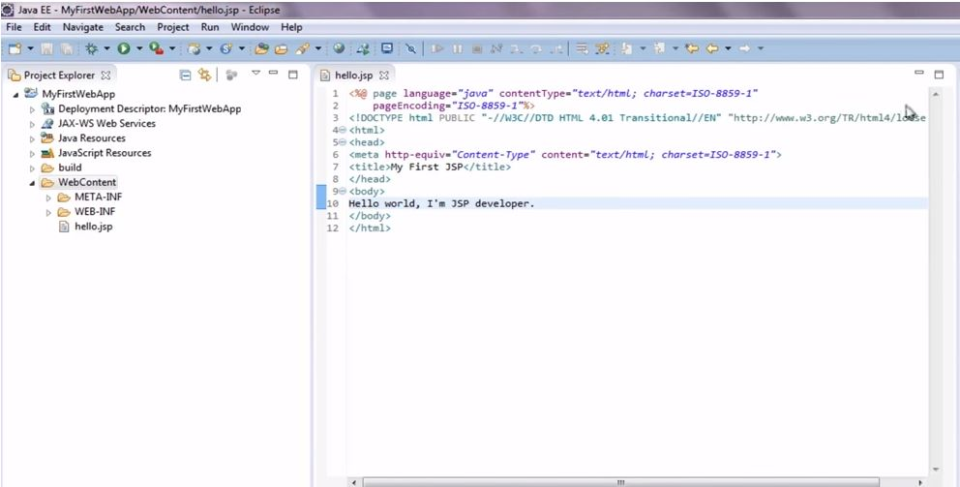

Jakarta EE 8 marks a new era in the Java ecosystem it gets the important Java EE project working under an open source process and paves the way for needed improvements. Thus, the community is discussing transitioning to the jakarta.* namespace. This means the Eclipse Foundation cannot use Java or javax in the project name or namespace for new features of Jakarta EE. Basically, Oracle gave the Java EE project to the Eclipse Foundation, but Oracle still holds the trademark.
#ECLIPSE FOR JAVA DEVELOPERS VS EE UPDATE#
The Jakarta NoSQL is based on Eclipse JNoSQL, which will be its reference implementation.Īnother update expected in Jakarta EE involves namespace. It's also a big step in getting the Java platform closer to a cloud-native approach, because NoSQL databases are widely used in cloud environments and improvement is expected. Jakarta NoSQL is a specification aimed at easing integration between Java applications and NoSQL databases, promoting a standard solution to connect them with a high level of abstraction. The main update expected in Jakarta EE 9 is the birth of the Jakarta NoSQL specification. Jakarta EE 8 is focused on updating its process to evolve, and the first updates in features will come in Jakarta EE 9. With this, the JESP promotes a new culture focusing on experimentation to evolve these specifications based on knowledge gained through that experimentation. The goal of JESP is to be as lightweight as possible, with a design that is closer to open source development and that keeps code-first development in mind. Specification Projects must engage in at least one Progress or Release Review per year while in active development.A ballot will be declared invalid and concluded immediately in the event that the Specification Team withdraws from the corresponding review.Service Release Review: 14 calendar days and.All specification committee approval ballot periods will have the minimum duration as outlined below (notwithstanding the exception process defined by the EFSP, these periods may not be shortened).Any modification to or revision of this Jakarta EE Specification Process, including the adoption of a new version of the EFSP, must be approved by a Super-majority of the Specification Committee, including a Super-majority of the Strategic Members of the Jakarta EE Working Group, in addition to any other ballot requirements set forth in the EFSP.The JESP is based on the Eclipse Foundation Specification Process (EFSP) with some changes, which are covered on the project page. The JESP is replacing the JCP process used previously for Java EE.

The Jakarta EE Specification Process (JESP) is the new process will be used by Jakarta EE Working Group to evolve Jakarta EE. With this, Jakarta EE 8 is a milestone in Java enterprise history, as it inserts these specifications in a new process to boost the specifications to a cloud-native application approach. The only change is the new process to evolve these specifications. The Jakarta EE 8 has the same set of specifications from Java EE 8 with no changes in its features. Thus, the Eclipse Foundation's first action was to change the process to evolve Jakarta EE.

To evolve these specifications for cloud computing, however, we cannot work with the same processes used on Java EE, because they are too slow for current enterprise challenges. This project is based on Java EE 8, and its specifications, Technology Compatibility Kits (TCKs), and Reference Implementations (RI) were all migrated from Oracle to the Eclipse Foundation. The Java ecosystem has a new focus on cloud computing, and Jakarta EE is key to that approach. Jakarta EE's goal is to accelerate business application development for cloud computing (cloud-native applications), working with specifications developed by many vendors. The speed of change has increased, with new technologies such as cloud computing being developed to provide better solutions, and Java EE needed to keep pace as well. Nonetheless, the enterprise world doesn’t stop, and new challenges emerge all the time. Developers may have questioned its features and evolving processes, but looking at its high usage and time in the market, its success is undeniable. Java EE was a very strong project that was widely used in many kinds of enterprise Java applications and many big frameworks, such as Spring and Struts. The Eclipse Foundation released Jakarta EE 8 on September 10, and in this article, we’ll look at what that means for enterprise Java. The project was migrated from Oracle to the Eclipse Foundation, and it is called Jakarta EE, under the Eclipse Enterprise for Java (EE4J) project. Now, Java EE has a new home and a new brand. However, it was created in 1999, under the name of J2EE, and is 20 years old, which means it also faces challenges in keeping pace with enterprise demands.


 0 kommentar(er)
0 kommentar(er)
